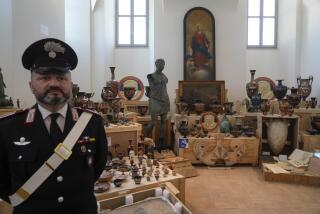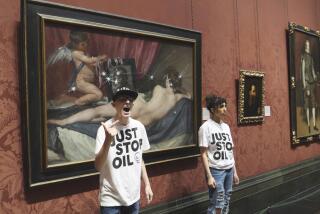Gunmen Steal 3 Works in Rome Museum
ROME â In Europeâs second major art heist this month, three masked gunmen in stocking feet subdued unarmed guards during the night and stole two paintings by Vincent Van Gogh and one by Paul Cezanne from the National Gallery of Modern Art, Italian officials said Wednesday.
Culture Minister Walter Veltroni called it the first known armed robbery of art from Italyâs much-pilfered museums. âArms and aggression were used, almost in the manner of a kidnapping rather than a theft of paintings,â he said. âThis is a qualitative leap into a new dimension of crime.â
The brazen robbery here and the baffling May 3 daytime theft of a Jean-Baptiste Camille Corot landscape from the Louvre in Paris underscored security concerns about some well-known European museums. The culprits managed to elude electronic surveillance in both.
Police Chief Antonio Pagnozzi called the Rome heist âa high-class job,â and his underlings gave this account: The gunmen apparently entered the gallery, on the edge of Romeâs Villa Borghese, with the last group of visitors Tuesday night and hid behind an exhibition room curtain until after the 10 p.m. closing.
Creeping across narrow âdead zonesâ not covered by the alarm system, they seized the three overnight-shift guards, forced one of them to switch off the alarms, seized their walkie-talkies and forced them all, bound and gagged, into a bathroom.
In a 15-minute sweep, the thieves helped themselves to Cezanneâs âLe Cabanon de Jourdanâ and Van Goghâs âThe Gardenerâ and âLâArlesienne,â scooped up the equivalent of $860 in ticket proceeds and a roll of tickets, and left by the front door with the paintings still framed.
Two hours later, workers at an adjacent cafe were locking up and telephoned to offer the guards coffee. When they got no answer, they went to the museum, saw a door ajar and summoned police.
Veltroni called the loss of the Postimpressionist paintings âa tremendous blowâ; one independent specialist estimated their combined value at $34 million. The unfinished Cezanne, showing a country cabin, was begun in 1906, the year of the French masterâs death, and was his last oil painting.
âThe Gardener,â depicting a downcast-looking man in a straw hat, dates from 1889, when Van Gogh was a patient at an asylum in St. Remy, France. âLâArlesienne,â a portrait of Madame Ginoux, the wife of a friend, was one of the Dutch artistâs last works before his suicide in 1890.
Paintings and other treasures disappear from church or state custody in Italy at a rate of 96 per year. But Tuesdayâs heist, the first from a major Italian museum since 1992, stunned officials at the well-run National Gallery. âThere were no armed guards, but there were custodians and alarm systems,â gallery spokeswoman Elena Di Majo said. âWe didnât think we had to put the army in front of the museum.â
The intruders benefited from a breakdown of the galleryâs closed-circuit television monitor. And like the thief who cut Corotâs âThe Sevres Roadâ from its frame in the Louvre, they apparently used an intimate knowledge of the targeted museum and its security gaps.
Designed as a palace, the Louvre has trouble accommodating modern security systems and lacks funding for them anyway. The Corot landscape, valued at $1.3 million for insurance purposes, was in a corner of a second-floor room that was neither under video surveillance nor wired to an alarm system.
âThe thief must have known what he was doing, that the painting was not monitored,â said Pierre Rosenberg, director of the museum, which was crowded with visitors the Sunday of the theft--the second from the Louvre this year.
The best-known masterpieces are somewhat protected from the booming international trade in stolen art by the difficulty of disposing of them.
A man claiming to have the stolen paintings called Italyâs ADN Kronos news agency Wednesday and said they would be returned under certain conditions, including political ones, to be announced later.
More to Read
The biggest entertainment stories
Get our big stories about Hollywood, film, television, music, arts, culture and more right in your inbox as soon as they publish.
You may occasionally receive promotional content from the Los Angeles Times.










